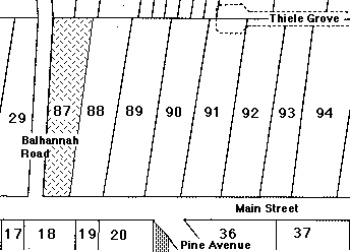LOCATION: 68 Main Street, Hahndorf
SHR 10490 – confirmed as a State Heritage Place 23 September 1982
 Hahndorf College 1888 [Freason's Illustrated Adelaide News}
Hahndorf College 1888 [Freason's Illustrated Adelaide News}
Introduction
Located at the corner of Main Street and Balhannah Road, the Hahndorf Academy has had a varied and volatile history. Few buildings in Australia can lay claim to such controversy from inception up until the current time. It has been stated that the Hahndorf Academy was the focal point that created the tourist industry that currently prevails in Hahndorf.
The publication, 'A College in the Wattles', by Reg Butler, is an excellent detailed and comprehensive history of the Academy. Launched during the 150th anniversary of Hahndorf's establishment, this book sets the Academy in an Australian context and provides short biographies of old scholars and teachers.
An article of interest concerning the Hahndorf Academy is that published in the 'Walkabout' magazine in 1964 by Prof. RWV Elliott.
In 1857 Traugott Wilhelm Boehm opened the Hahndorf Academy to provide 'a sound and good English and German education, in order to enable its pupils to enter the learned professions or to prepare for commercial life'. It did not offer religious instruction, and gained an enviable reputation for higher learning. The Academy became a boarding school in 1863.
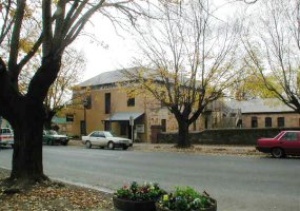 Hahndorf Academy from Main Street (2002)The stone building was constructed in several sections. It first opened as a single storey structure, but in 1871 the front two-storey section was added. A government grant in 1872 enabled another portion of the building, with the corner tower, to be added.
Hahndorf Academy from Main Street (2002)The stone building was constructed in several sections. It first opened as a single storey structure, but in 1871 the front two-storey section was added. A government grant in 1872 enabled another portion of the building, with the corner tower, to be added.
In 1877 Boehm sold the school to the Lutheran Church for £700, and it became a Lutheran college and seminary. Boehm repurchased it in 1883, but again sold in 1886 – this time to an Englishman, DJ Byard, who changed its name to Hahndorf College, but continued the institution's excellent academic tradition. Byard was educated at Eton and had a great love of music. This early commitment to the arts and education attracted students from across Australia. In total more than 700 students passed through the Hahndorf Academy/College, and included many prominent political, commercial, financial and pastoral families. The Elder Conservatorium of Music at the Adelaide University was founded by former Academy students.
When Education Department high schools were introduced in 1916, the building was sold and ran as a hospital and nursing home from 1917-1937. From then on it served as council offices, betting shop, dentists' rooms, army headquarters, flats and a recreation centre.
In 1966 it was restored by new owners, Mr & Mrs Walter Wotzke, who opened the building as a gallery in 1967 – on the 90th birthday of Sir Hans Heysen.
In 1988 the building was purchased by the Hahndorf Academy Foundation Incorporated, and subsequently in 1998 was purchased by the District Council of Mount Barker who continue to maintain it. Today the Hahndorf Academy is one of the largest regional art galleries in South Australia. It also contains a German Migration Museum and a large retail outlet, and is one of Hahndorf's main cultural tourist attractions.
Traugott Wilhelm Boehm
Traugott Wilhelm BOEHM (1836 - 1917) arrived aboard the 'Zebra' with his parents in 1839, being the youngest of six children.
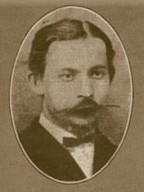 T.W. ('Chibby') Boehm founded the Hahndorf Academy in 1857 and directed it for 30 years.
T.W. ('Chibby') Boehm founded the Hahndorf Academy in 1857 and directed it for 30 years.
After attending the Hahndorf church-school, he enrolled at Pastor Fritzche's 'pioneer Lutheran college of the southern hemisphere' at Lobethal (about 15 miles north of Hahndorf) to be trained as a school teacher. Upon completion of his studies, which was followed by some practical training in the Barossa Valley (another area of German settlement in South Australia), Boehm was appointed to the church-school at Hahndorf in April 1854.
Boehm had a strong desire to add secular subjects to the religious curriculum approved by the Church. The congregation disagreed most vehemently, leaving Boehm little option but to open a school of his own with the help of his family and a grant-in-aid from the Central Board of Education. Set up in 1850, the Board had consistently refused to subsidise schools devoted to teaching a particular denominational doctrine. In this way, Boehm's school, which ultimately grew to become 'The Hahndorf Academy' as is known today, was established as a public school with no religious instruction in its curriculum.
After Boehm sold the whole establishment in 1886, he moved to Murtoa, Victoria the following year where he opened a private school where opportunities for higher education were offered. This school was taken over by the Lutheran Church in 1890 and established as Concordia College. Concordia College was subsequently moved in 1905 to its present site at Highgate, a suburb of Adelaide, South Australia.
After retiring to Warracknabeal, Victoria, Boehm died in May, 1917.
Hahndorf Academy
In 1857, T.W. Boehm opened his school, naming it the Hahndorf Academy, which was the first government supported primary school, with the object of providing 'a sound and good English and German education, in order to enable its pupils to enter the learned professions, or to prepare them for commercial life.'
Fees were charged at 2 guineas a quarter for day-scholars and from 10 to 13 guineas for boarders.
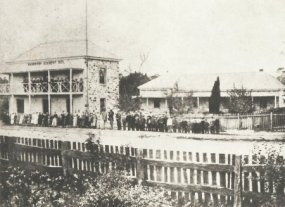 Hahndorf Academy in 1871 before it became a Lutheran Teachers Seminary in 1876.The school was initially located in the single-storey cottage which is still standing on the site today at the rear of the larger building. The school grew in size and prestige, becoming a secondary boarding college in 1871 when the two-storey building was built.
Hahndorf Academy in 1871 before it became a Lutheran Teachers Seminary in 1876.The school was initially located in the single-storey cottage which is still standing on the site today at the rear of the larger building. The school grew in size and prestige, becoming a secondary boarding college in 1871 when the two-storey building was built.
Also known as Boehm's Boarding School, it soon established a good reputation and attracted more and more pupils. 'Chibby' Boehm , as he was nicknamed, was certainly passionate about providing a liberal education but his finances rarely kept pace with his ambitions. Teaching was in both German and English with a wide variety of subjects, and a strong reputation was built for art, physical education, academic scholarship, commerce and music.
Pupils were attracted from interstate, as well as prominent South Australian Families seeking a well-rounded education for their children. A former student and master, Professor I.G. Reimann, established Australia's first music school, which later became part of the University of Adelaide's Elder Conservatorium.
In 1872, the Academy received a Government grant-in-aid and, to meet the need for more accommodation, the main building with the corner tower was added a few years later.
Hahndorf Lutheran Teachers' Seminary
Carl Friedrich Adolph STREMPEL (1831 - 1908) was appointed director of the boarding section of Hahndorf College after it opened in 1876 in the Hahndorf Academy building. After the college was sold in 1883, he continued to train teachers for Church schools.
By 1877, Boehm found himself financially embarrassed due to the expenses involved in the building additions plus other personal debts. He offered to sell the Academy to the Lutheran Church, which was accepted at a price of £700, so that it could also be used as Lutheran Teachers' Seminary. It was renamed the Hahndorf College and Boehm remained as Principal.
For the next seven years the institution operated with two departments; one for higher education open to fee paying students, and the other a teachers' seminary for church-schools. During this period 13 Lutheran teachers had graduated from the seminary, some of whom later entered the ministry.
In 1883, Boehm offered to buy back the the college from the Church at the original purchase price, which was accepted. Thus the college ceased to be a church institution from that date.
Hahndorf College
Boehm carried on for a few more years, but in August 1886, he sold the whole establishment to D.J. Byard and H.S. Steer.
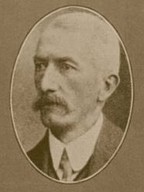 Boehm's successor, Douglas J. Byard M.A. was in charge of the college until it closed.Douglas Byard, an Oxford Master of Arts and Anglican lay preacher, had arrived in Australia in 1884. Under his leadership, the 'Hahndorf College' again flourished and became even more widely recognised. With its tradition of scholastic excellence students were attracted from far afield from all over Australia. Some came from cattle stations in Queensland's Gulf country, while others travelled by wool barge down the Darling River from Wilcania in New South Wales. Unlike Boehm's 'Academy', Byard's 'Hahndorf College' was for boys only. Men who became prominent in medicine, law and commerce were products of the 'Hahndorf College'.
Boehm's successor, Douglas J. Byard M.A. was in charge of the college until it closed.Douglas Byard, an Oxford Master of Arts and Anglican lay preacher, had arrived in Australia in 1884. Under his leadership, the 'Hahndorf College' again flourished and became even more widely recognised. With its tradition of scholastic excellence students were attracted from far afield from all over Australia. Some came from cattle stations in Queensland's Gulf country, while others travelled by wool barge down the Darling River from Wilcania in New South Wales. Unlike Boehm's 'Academy', Byard's 'Hahndorf College' was for boys only. Men who became prominent in medicine, law and commerce were products of the 'Hahndorf College'.
 Illuminated Address presented to Douglas J Byard
Illuminated Address presented to Douglas J Byard Main Street and Hahndorf Academy 1912.The Hahndorf College played a leading role in the Adelaide Hills, and its records include names such as Bonython, Downer, Resch and von Doussa. Sir Douglas Mawson's polar expedition was joined by old scholar Cecil Madigan. The large linden-tree behind the College was planted by Mr Byard in 1908.
Main Street and Hahndorf Academy 1912.The Hahndorf College played a leading role in the Adelaide Hills, and its records include names such as Bonython, Downer, Resch and von Doussa. Sir Douglas Mawson's polar expedition was joined by old scholar Cecil Madigan. The large linden-tree behind the College was planted by Mr Byard in 1908.
Mr Byard returned to England in 1916 and lived in retirement at St. Leonards-on-Sea, Sussex. He died in 1946 at the age of ninety.
An Illuminated Address was presented to Douglas John Byard at 'Ambleside (Hahndorf)', 22 April 1918. The address was an acknowledgement of Byard and the work he did in and for the town. 3 vignettes of photographs of the town are on the left side of the manuscript.
In 1912, the closure of the college marked the end of its long standing role as an educational institution.
Old Hahndorf Collegians Reunion 1936
More than 60 old Hahndorf Collegians attended a reunion dinner held in the Hotel Ambleside in the ‘Back to school Celebrations’ held in 1936. In 1976, the hotel was renamed to its original name of the German Arms Hotel, Hahndorf)
Mr Boehm opened the College in 1857 and boys attended from all over the district and in 1886, Mr D. J. Byard bought the property and carried it on as the Hahndorf College until 1916 when it closed.
 Back Row: Heine Storch, Caw Barritt, Bill Braendler, ? Dolling, Albie Walton, Bill Spoehr, Vic Braun, Louis von Doussa junior, Frank Paltridge, Bill Pain, Allan Basey, Cyril Rundle, Jasper Barritt.
Back Row: Heine Storch, Caw Barritt, Bill Braendler, ? Dolling, Albie Walton, Bill Spoehr, Vic Braun, Louis von Doussa junior, Frank Paltridge, Bill Pain, Allan Basey, Cyril Rundle, Jasper Barritt.
Third Row: Charlie Plowman, Lewis Parker, Robert Peake, John Hill, Garn Grieve, Murray Pickering, Frank Byard, Lee Paltridge, Herb Williams, Cam Deland, Gar Pritchard, Bernie Stephenson, Alf Bremer, Sophus Kirchauff, Adloph Andrae, Arthur Furniss, Fritz Wotske, Wilhelm Zschech.
Second Row: Fred Smith, Bill Minkwitz, George Wooley, Allen Willcox, EG Kaesler, CGE Nitschke, Joe Rundle, Percy Stephenson, Ted Peterson, Frank Daw, Bill Murray, Harry Wittwer, ‘Skip’ Storch.
Front row: Lance Byard, Cedric Noon, ?, CAL Schinckel, WAE Schinckel.
Sources: Photograph: B 62884 Courtesy of the State Library of South Australia
A 994.94232 BUT LH College in the Wattles by Reg Butler
Courier Newspaper 26 November 1936
Local History Centre Database - https://localhistory.mountbarker.sa.gov.au/
Subsequent Uses
 Hahndorf Academy c1950 (with balconies still intact).
Hahndorf Academy c1950 (with balconies still intact).
Mr H. Hirthe was the next owner of the property.
From 1917-1937, the building was used as a nursing home and hospital run by Nurse B. Schmidtke. During these years, 999 patients were cared for and 580 babies born in its rooms. It then housed council offices, local military headquarters during World War II, a betting shop and a dentist who was in the habit of disposing extracted teeth through a hole in the floor. Subsequently, it served as a private dwelling, as housing flats, and as a recreation centre.
Some years after Mr Hirthe's death in May 1939, the property was bought by Mr H.O. Haebich. Its life as a rooming house came to an end when Otto Haebich began converting the place to flats. His sudden death in November 1959 when he was in the throes of renovations resulted in gaping holes being left in the floors and walls, and with the property in a general state of disrepair.
Sale and Possible Demolition
The property was then offered for sale by public auction in April 1960. As the Mount Barker Council had declared the building to be unsafe, this sale would have meant the demolition of the building.
 The derelict Academy building due for demolition, 1960.
The derelict Academy building due for demolition, 1960.
The property, being located on a corner site in the centre of the township on the then main Adelaide-Melbourne highway, attracted the strong interest of a petrol company which had the intention of demolishing the Academy and building a service station on the site. Some of the local community supported this proposed action due to the building's bad state of repair and the high cost of restoration, while others were anxious to see the Academy preserved because of its history and what it had meant to Hahndorf in the past. Opinion was very much divided.
As reported by Prof. R.W.V. Elliot in 'Walkabout' (April 1964) concerning the day of the public auction, 'only the concerted action of several prominent South Australian citizens, the generosity of an Adelaide master builder, and the petrol company's magnanimous withdrawal from the sale saved it from destruction.'
Latvian born Karlis Lidums (Adelaide Building Co.), in a gesture of gratitude to his adopted country, bought the building to keep it unchanged until such time as the proposed 'Hahndorf Academy Museum Trust' could be formed and had sufficient finance to take over the building. (refer to Foot Note below)
Foot Note: - 'Sale and Possible Demolition' - I recall a conversation held many years ago (obviously 1960) in my parents Hazelwood Park home involving my father, L (Mick) Finnis, with A M Ramsay (General Manager-South Australian Housing Trust) and Jim Slade (Director-Public Buildings Department) in which the above was discussed. Apparently, (Sir) Thomas Plaford, South Australian Premier, had instructed Ramsay to ascertain if there was any way in which the 'Hahndorf people' could be helped to save the Academy building without directly involving the State Government. Playford did not want the State Government to be involved in any expenditure or to be seen to be supporting the project as he did not wish a precedent to be set for others to seek similar Government assistance. Slade considered that the Academy should be demolished as it would be considerably cheaper to do this and build a new building. He believed that restoration had no merit and would be a complete waste of effort and money. Ramsay however supported the restoration of the Academy as he was an early conservationist. Slade did however suggest that Karlis Lidums (Adelaide Building Company) might be interested and that he would contact him and arrange for a meeting between Lidums and Ramsay for the matter to be discussed. This meeting obviously was held resulting in Lidums purchasing the Academy and thus saving it from demolition at that time. (It should be noted that this conversation was held at a time when it was the norm for old buildings to be demolished to make way for the new. Restoration and conservation were generally considered not to be an option irrespective of any historical or other value in the original building/s) - (Tony Finnis)
The Hahndorf Academy Museum Trust
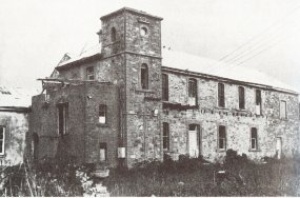 Academy in mid 1960's after storm damage.In 1961, 'The Hahndorf Academy Museum Trust' was founded under the chairmanship of Dr. Derek van Abbe, then head of the Department of German at Adelaide University, with Miss Josephine Heysen (Sir Hans Heysen's granddaughter) as secretary. The aim of the Trust was 'to restore the building to such a shape that it will be able to take its place worthily among the historic monuments of South Australia, and to make it a museum of local German and English antiquities and early South Australian history.'
Academy in mid 1960's after storm damage.In 1961, 'The Hahndorf Academy Museum Trust' was founded under the chairmanship of Dr. Derek van Abbe, then head of the Department of German at Adelaide University, with Miss Josephine Heysen (Sir Hans Heysen's granddaughter) as secretary. The aim of the Trust was 'to restore the building to such a shape that it will be able to take its place worthily among the historic monuments of South Australia, and to make it a museum of local German and English antiquities and early South Australian history.'
By February 1961, Sir Hans Heysen had made the first of several valuable gifts of art work to draw public attention to the Academy. The Trust aimed to raise funds to restore the building and establish a rural museum and cultural centre.
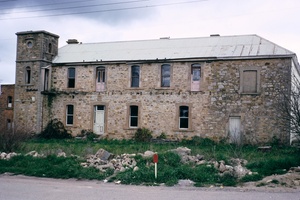 Academy Derelict c1965In 1963, the Trust took over the property from the Adelaide Building Company. There was a concerted effort to find support from government and private sources. Unfortunately, any funds raised were needed to attempt to repair storm and other damage which occurred during the 1960 to 1963 seasons. Roof repairs were required and the damaged balcony and verandah had to be removed. The building had degenerated into a dilapidated wreck, so much so that community hostility towards the project was increasing at a great rate.
Academy Derelict c1965In 1963, the Trust took over the property from the Adelaide Building Company. There was a concerted effort to find support from government and private sources. Unfortunately, any funds raised were needed to attempt to repair storm and other damage which occurred during the 1960 to 1963 seasons. Roof repairs were required and the damaged balcony and verandah had to be removed. The building had degenerated into a dilapidated wreck, so much so that community hostility towards the project was increasing at a great rate.
Late in 1966, after the State Government decided not to provide any assistance for restoration, the Mount Barker Council served the Trust with exactly one month to effect repairs. This was an impossible demand and the Trust had no option but to place the Academy building up for sale once again. The Trust therefore resolved to sell the property to any party interested in the preservation of the old Academy.
The Hahndorf Academy and German Folk Museum
In November 1966, Mrs Elva Wotzke purchased the property, however it was necessary for her to take the Mount Barker Council to court to ensure she was able to restore the building within a reasonable time. With her husband's, Walter Wotzke, support she courageously faced the herculean task of restoring the old building. Their work was considerably aided by local people and artists to enable restoration to take place.
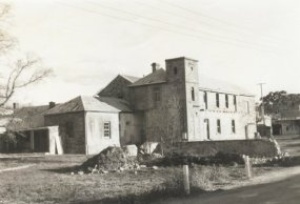 Academy July 1967 during restoration.In October 1967, 'The Hahndorf Academy Galleries and German Folk Museum' opened for business by paying tribute to Sir Hans Heysen on his 90th Birthday with an exhibition of his work. The German Ambassador, His Excellency Dr J.F. Ritter, performed the opening ceremony to near universal acclaim from some 2000 visitors in attendance.
Academy July 1967 during restoration.In October 1967, 'The Hahndorf Academy Galleries and German Folk Museum' opened for business by paying tribute to Sir Hans Heysen on his 90th Birthday with an exhibition of his work. The German Ambassador, His Excellency Dr J.F. Ritter, performed the opening ceremony to near universal acclaim from some 2000 visitors in attendance.
Under the directorship of Walter Wotzke and through its programme of exhibitions by noted and emerging artists, the gallery gained a reputation that drew visitors from all over the world, including the Duke of Edinburgh, the Australian Governor General Sir Zelman Cowan, soprano Rita Streich, several State governors and other dignitaries. Equally distinguished personalities appeared on a regular basis, and gallery attendants never knew who to expect next.
The Academy also became well known for its concerts. Walter Wotzke's famous cousin, Brenton Langbein came from Zurich to perform there. With the help of fellow artist Colin R. Gardiner, the exhibitions were always elegantly hung and lit. Walter Wotzke himself was an excellent showman with a genuine passion for art, Hahndorf and its Academy. People were drawn to the excitement and camaraderie within its walls.
The Heysen Room was established to display the nine drawings Sir Hans Heysen had donated to the Trust during its struggles to raise funds plus the bronze head of Sir Hans by the South Australian artist and sculptor John Dowie.
On the Academy's first floor, Elva Wotzke arranged the exhibits she had so painstakingly collected for her Hahndorf and German heritage cottage museum in the mid-1960's. This substantially formed the basis of the current 'German Migration and Folk Museum'.
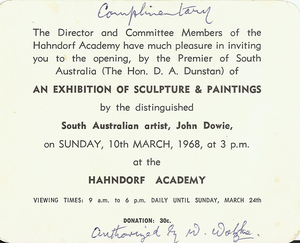 For his conspicuous encouragement of aesthetic endeavour, Walter Wotzke received an OAM in 1978.
For his conspicuous encouragement of aesthetic endeavour, Walter Wotzke received an OAM in 1978.
Late in 1984, Walter Wotzke decided to sell the Academy so he could devote full time to his watercolour painting. As reported in 'The Courier' (local newspaper) on November 14, 1984: One of the town's most outstanding historic landmarks is to be auctioned next month. The imposing Hahndorf building has been an art gallery and museum since it was rescued from demolition and restored by present owner Mr Walter Wotzke. The original Hahndorf Academy, built in 1857, was a single-storey building (now a private residence) at the rear of the gallery which was added in 1871. As an 'institute of higher learning', the Hahndorf Academy attracted students from all over the country, and many well known names appear in school records - Downer, Fuller, Von Doussa etc.
After a considerable amount of confusion, the auction of the property held in November 1984 resulted in the property remaining unsold. The next few years were a virtual stalemate while committees deliberated, deputations were made to the state government, and consultants prepared a feasibility study for the Mount Barker Council. During this period the contents and displays within the Academy were allowed to run down. Finally, as a result of a public meeting held in April 1987 and chaired by local Federal Parliamentarian, Alexander Downer, it was decided to revitalize the dormant Academy Trust to purchase the property and make it a permanent public building.
The Hahndorf Academy Foundation Inc.
'The Hahndorf Academy Museum Trust Incorporated' came out of recess in 1987 under the chairmanship of Dr. Peter Heysen, Sir Hans Heyson's grandson. Renamed 'The Hahndorf Academy Foundation Inc.' the group became the owners on 20 December 1988.
As renovations progressed, the Hahndorf Branch of The National Trust of S.A. set up an exhibition of historical photographs and drawings which raised $2,000 for the Foundation in a few days. On 6 January 1989, the new era of public ownership commenced at the Academy with a Heysen retrospective exhibition, opened by Colin Thiele.
In 1995, an unfortunate event brought the attention of the nation's media to the Academy. A total of 29 Heysen paintings, consisting of those lent by the family for display as well as seven drawings donated by Sir Hans Heysen, were stolen from the Academy. It was not until 1997 that these Heysen works were recovered.
Struggling to pay the bank's interest rate let alone reduce the principal debt, the Foundation sought unsuccessfully for assistance from state and local government to add to its list of donors. It wasn't until 1996, that the 'Hahndorf Academy Foundation' succeeded in convincing Mt. Barker Council to give support in principle to the purchase of the Academy if the State Government would provide a matching $100,000. This resulted in the South Australian Premier John Olsen handing over a cheque for $100,000 to equal Mount Barker District Council's contribution at the opening of the Heysen Festival on 3 October 1998.
Today the building is owned by the Mount Barker District Council and continues life under 'The Hahndorf Academy Foundation Inc.' thus ensuring the preservation of this State Heritage building and grounds. It provides the community with a public art gallery, featuring works by well known local and Australian artists with exhibitions on a regular basis. The associated German Migration and Heritage Museum is dedicated to regional heritage. The Hahndorf Academy also has a large retail area showcasing Adelaide Hills artists and craftspeople and a number of 'artists in residence' studios. The Foundation is currently working on upgrading its historical collection and museum.
Upgrading of Academy and Relocation of AHVIC
Commencing September 2010 and completed by the following December, construction of new toilets and refurbishing of the existing kitchen within the Academy building was carried out. The project was funded by $220,000 from the Mt Barker Council's budget and a $65,000 grant from the Federal Government's Regional and Local Community Infrastructure Program.
On completion of this work in December 2010, the Adelaide Hills Visitor Information Centre (AHVIC) relocated from its existing location in Main Street and moved into the front room of the Academy Building.
|
Please note that information regarding the history of the Academy was obtained mainly from: |
Early Ownership of Site
Information from The Hahndorf Allotments Database. (Reg Butler)
| Old Lot No. | New Lot No. | Street No. | Street Name |
| House 27 | N.H. 87 | 68 | Main Street |
| Year Sold | New Owner | Occupation | Owner's Home |
| 1839 | George Boehm | carpenter | Hahndorf |
| 1853 | George Boehm | farmer | Hahndorf |
| 1875 |
Eduard Reimann Eduard Schroeder |
farmer farmer |
Hahndorf Hahndorf |
| 1875 | Wilhelm Boehm # | teacher | Hahndorf |
| 1877 | Lutheran Church ELSA | ||
| 1883 | Wilhelm Boehm | teacher | Hahndorf |
| 1886 | Mortgage Co of SA | business firm | Adelaide |
| 1886 |
Douglas Byard % Herbert Steer |
teacher teacher |
Hahndorf Hahndorf |
| 1887 | Douglas Byard | teacher | Hahndorf |
| 1919 | Heinrich Hirte | farmer | Mt Barker Junction |
| 1939 | Bertha Schmidtke | midwife | Hahndorf |
| 1958 | Dulcie Paech | wife of Louis Paech | Hahndorf |
| 1958 | Otto Haebich | retired | Hahndorf |
| 1960 | Adelaide Building Co Ltd | business firm | Woodlands Park |
| 1964 | Hahndorf Academy Museum Trust | business firm | Hahndorf |
| 1966 | Elva Wotzke * | wife of Walter Wotzke | Hahndorf |
| 1988 | Hahndorf Academy Foundation | business firm | Hahndorf |
| 1998 | District Council of Mount Barker | Local Council | Mount Barker |
Notes:
-
NH 87 & NH 100 originally joined as House Allotment 27. AA Light must have divided the allotment in his re-survey of Hahndorf in 1862.
-
1875 - E Reimann & E Schroeder sub-divided NH 87: Sub-lot 1: No 68 Main Street and No 70 Main Street - W Boehm. This is part of the property of the Hahndorf Academy. Sub-lot 2: No 2 Balhannah Road & No 4 Balhannah Road - G Rohrlach.
-
1956 - N Kruse sub-divided Sub-lot 2: Sub-lot 3: No 2 Balhannah Road - J Seifert.
-
1970 - part of the land taken to widen Balhannah Road.
-
** G Boehm's widow, Caroline, nee Koenig, had a life interest in the property. She died 1875. The same executors acted at the time of both deaths.
-
# TW Boehm built the two-storeyed section of his Hahndorf College on this site in 1882.
-
% D Byard conducted the Hahndorf College as a school until 1912.
-
B Schmidtke ran a lying-in hospital in the former College building between 1919-1935.
-
* The Hahndorf Academy has remained as an art gallery and local history museum since 1967.
-
4073/656 Metric title.

